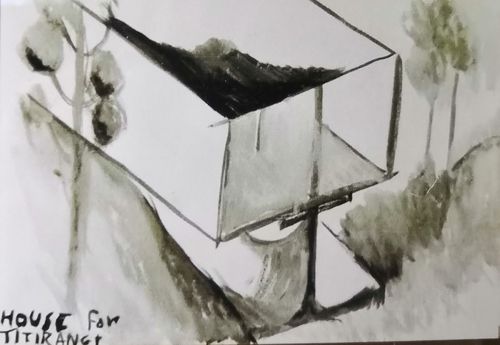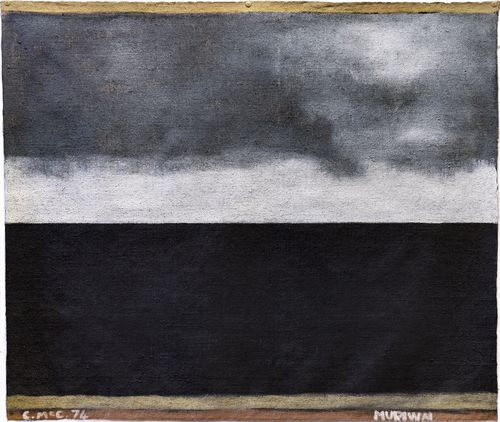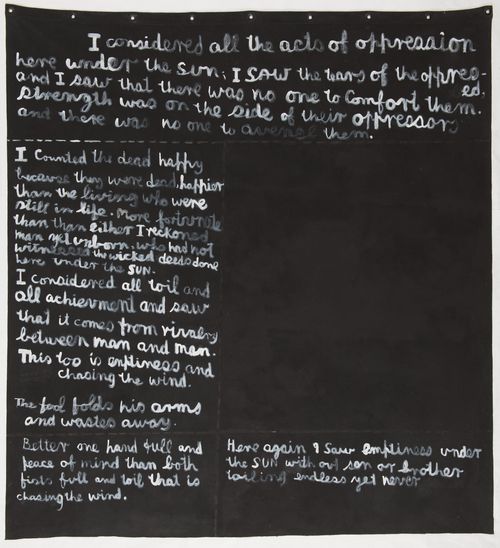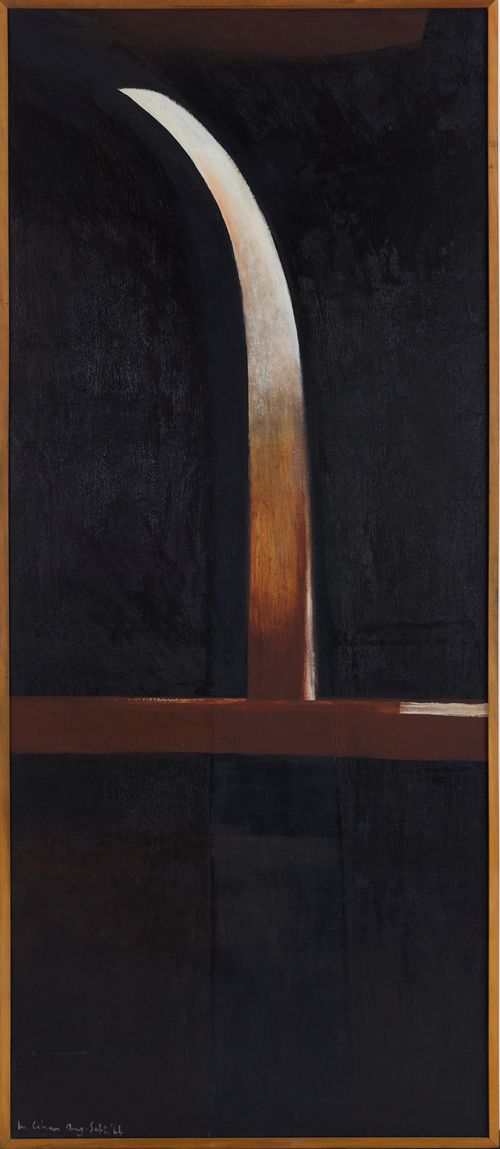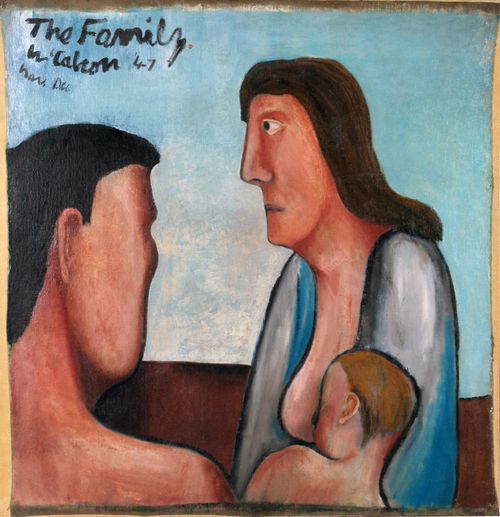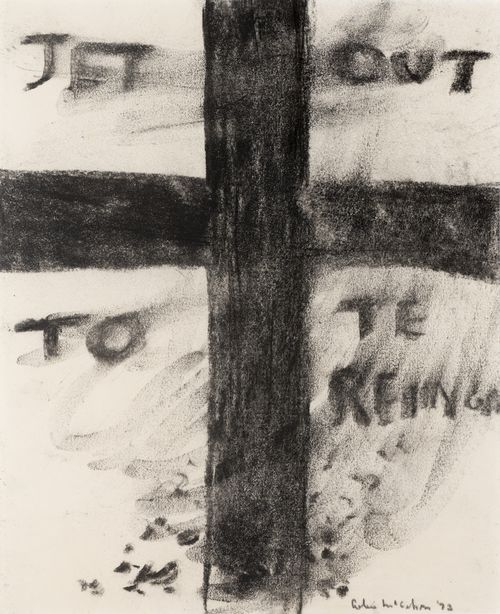Landscape theme and variations (series A)

Colin McCahon, Landscape theme and variations (series A), 1963, oil on 8 unstretched jute canvases, 1750 x 840 mm. Courtesy Victoria University of Wellington and McCahon Research and Publication Trust

Angels and bed no. 4: Hi-fi, 1976, synthetic polymer paint on unstretched canvas,
3440 x 5440 mm. Courtesy Victoria University of Wellington and McCahon Research and Publication Trust
Sue Gardiner
Musical McCahon
It would be good to investigate the musical in McCahon’s work. Yes, he worked with theatre design and stage performance. Yes, I am told he listened to a lot of music, and that the record player at the McCahon House played a central role in the social times when friends gathered with the family at the tiny Titirangi home. But what of the musical qualities of the paintings?
I wish I was better qualified to provide insight into this and maybe it is for more musically learned people to do so. In the meantime, I am delving into the convenience of internet quotes to read more about the relationship between music and art, something that has been well explored by the likes of Brian Eno and artists like Phil Dadson in New Zealand, whose love of visual music is well known. Eno once said:
In the 1960s when the recording studio suddenly really took off as a tool, it was the kids from art school who knew how to use it, not the kids from music school. Music students were all stuck in the notion of music as performance, ephemeral. Whereas for art students, music as painting? They knew how to do that.
How is the musical experienced in McCahon’s paintings? I can only rely on my own memories of felt experiences, and intuitive perspective; so, it seems there are two ways to think about it. From one perspective, there is the musical response felt when experiencing a carefully nuanced selection of works and from the another, there is the musical compositions found in the works themselves.
First from the perspective of ‘The Listener’ (as McCahon titled a 1947 painting), or the viewer. I certainly experienced a strong intuitive musical response when recently visiting the three rooms that make up A Place to Paint: Colin McCahon in Auckland, at the Auckland Art Gallery Toi o Tāmaki. Curated by Ron Brownson and Julia Waite, this exhibition brings McCahon’s sense of place alive—be it quiet and spiritual, deep in the bush, walking the beach, or within the thinking space of a small room.
I was with a small group of theology graduate students when I first walked into the exhibition spaces, and felt as we walked through the rooms as if an orchestra followed. We all immediately felt a shared sense of stillness and quiet as we were greeted, by way of introduction, to the modesty of three works painted in Titirangi during the 1950s. It was as if the flute and wind instruments were gently introducing us to the visual symphony of the Titirangi bush and French Bay landscape.
In the second room, we encountered the recently restored East window; Convent Chapel of the Sisters of our Lady of the Missions, Auckland (1965). Being with this group of theology students, I felt an immediate intensity in their looking, a yearning to see everything—to feel everything—coupled with a sense of calmness; a response to familiar symbolism. Musically, the associations were immediate; the reverential string section was with me now; pacing us through our meditations and spiritual contemplation as we took in McCahon’s playful use of symbols and language. The whispers of the nun’s voices from the Upland Road convent echoed metaphorically in the space.
Here perhaps too, with the other three works in the room, the musical associations can be continued. The Way of the Cross (1966), unfolds horizontally to me like multi-layered musical notation for prayer—tracing the gently curving breaths/rises and falls of the hills and valleys. The staccato; punctuations of the Maltese wooden crosses and their corresponding echo-like shadows. The painting's text introduces the voice—a poetic lyric tracing a narrative across the panels.
In Numerals (1965), the numbers act like a rhythmic sequence—pacing us along the length of the painting according to an inbuilt measure of time. While a metronome helps keep pace of a musician’s rhythm, here it is the sequence of numbers as well as changing light and dark, spatial divisions, and alterations in scale that push us along the length of this work. What are the beats per minute? Of note: Colin McCahon saw Jackson Pollock’s Autumn Rhythm (Number 30) (1950), at the Metropolitan Museum of Art in New York in 1958, which had an immediate effect on him.
In conversation with this work, along another wall, is Landscape theme and variations (series A) from 1963. Here the title makes a direct correlation to the titles of many musical compositions from Variations on a Theme by Joseph Haydn composed by Johannes Brahms in 1873 to John Cage’s Variations I–VIII from 1958. In McCahon’s work, using the principles of variation where visual material is repeated in an altered form, the forms and shapes create an easily recognisable, accessible rhythmic structure to the work. Like a musician with a stock of familiar sounds they know will always appeal to the audience, the curved hill, defining the left edge then the right, is a vital part of McCahon’s repertoire for those he wanted to reach out to.
Again, another Brian Eno internet accessed quote fits well here to my mind:
There are certain sounds that I've found work well in nearly any context. Their function is not so much musical as spatial: they define the edges of the territory of the music.
It is when we as viewers/listeners enter into the third movement/room of the exhibition at the Auckland Art Gallery Toi o Tāmaki, that finally the full orchestra reaches crescendo—bold contrasts, imaginative leaps and flights of dreaming, floating thoughts and lingering spirits—magnificent works surround us. Written text is painted as if we are intended to read it aloud; points of emphasis and moments of pause are found. Ultimately though it is the pattern of the notation, rather than the capacity of the language, that keeps our eyes engaged. Finally, on the end wall, the timpani player hits the drumhead with force and leaves us speechless and breathless—the angels surround us. Angels and bed no. 4: Hi-fi (1967-77) has all the theatre and drama you would expect, even down to the canvas looking more like a stage where the visual elements act like props. There is a sweeping white line that traces a route between two of these bold geometric shapes—like the sweep of the conductor’s baton, it brings the whole composition together into a sense of unity.
